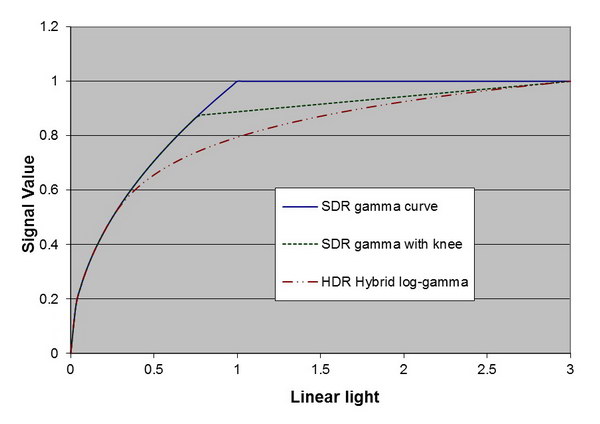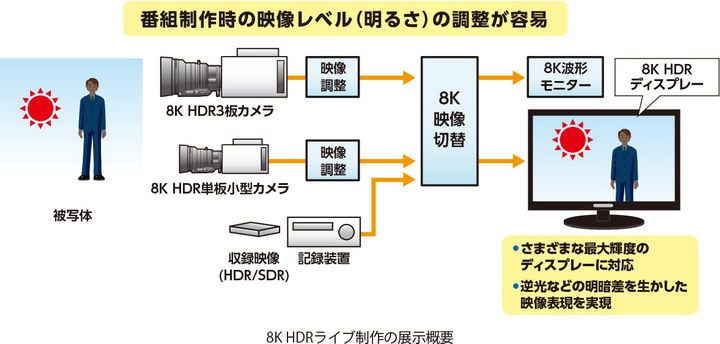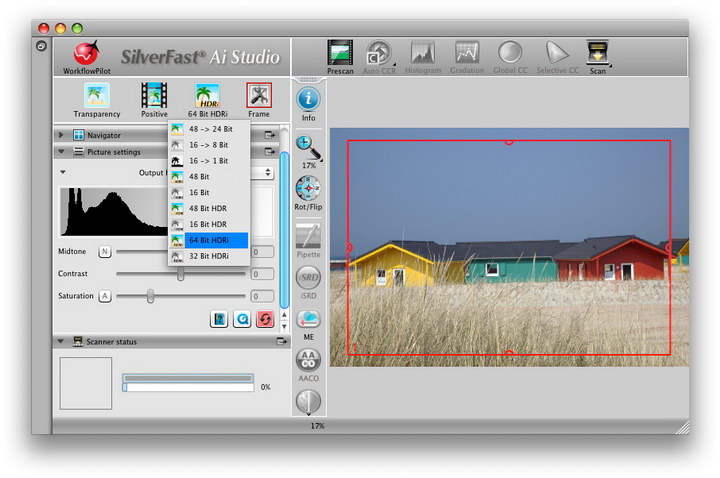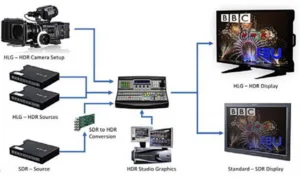I’ve written about high dynamic range (HDR) systems several times recently. Most of the focus has been on Dolby Vision and HDR10, primarily because content formatted for these two HDR systems is available in the US. While talking to an industry expert at the Samsung HDR event, he told me there are actually 10 HDR systems currently making the rounds. What are the other eight?

I was told that Dolby Vision was the only one of the ten systems that required dedicated hardware support – i.e. a SoC HDR processor with features licensed from Dolby. The other nine systems only require updated firmware in a more generic SoC to be displayed correctly on an HDR TV. The Dolby Vision SoC can run this software so, in theory, a Dolby Vision-equipped HDR TV can run any of the ten systems.
Without a Dolby license, the SoC on other HDR TVs can run decoders for any of the other nine systems, I was told. Therefore the TV manufacturers and, ultimately, the consumer will face a choice between a HDR TV that supports Dolby Vision and every other proposed HDR system or does not support Dolby Vision but does support all other HDR systems.
Perhaps the number three system behind Dolby Vision and HDR10 (a European might rate it as #2 or even #1) is the system developed by the British Broadcasting Corporation (BBC). The BBC has developed a system that uses a Electro-Optical Transfer Function (EOTF) called Hybrid Log-Gamma (HLG). This differs from Dolby Vision and HDR10 which both use the Dolby-developed PQ EOTF. This HLG EOTF is said to be more backward-compatible with standard dynamic range (SDR) systems than the PQ EOTF.
The best public statement of the BBC system is in BBC Whitepaper WHP 309, which was developed from a paper presented at IBC 2015 in September 2015. The HLG EOTF has also been standardized by the ITU, along with the PQ-EOTF, in Recommendation ITU-R BT.2100-0.
 Hybrid Log-Gamma Compared to SDR Gamma Curves for Acquisition (OETF)
Hybrid Log-Gamma Compared to SDR Gamma Curves for Acquisition (OETF)
The eventual look of a HDR or SDR image on a consumer’s TV screen strongly depends on how the image was acquired and the opto-electronic transfer function (OETF) used in the camera. With a conventional SDR gamma curve, 100% light produces a 100% signal level. All light levels above 100% are clipped to 100% signal and all detail and brightness information is lost. This information comes from highlights such as specular reflections, exactly the type of image content a HDR system wants to acquire and display. A modified gamma curve with a knee can produce signals for light levels up to 300% of the nominal but the presence of the knee causes computational and perceptual problems. The HLG OETF and its companion HLG EOTF are designed to acquire image brightness in the range of 0% (black) through 100% (diffuse white) to 300% (specular highlights) and scale these light levels into the same 0% – 100% signal range used by SDR systems.
According to the BBC, this results in a slight compression in the mid-range tones compared to a SDR or a PQ EOTF system. They say that both theoretically and experimentally, this does not lead to visible banding in real images although slight banding can be visible in certain artificial images specifically designed to maximize the visibility of banding.
Images coded with a HLG OETF/EOTF have several advantages over images coded with a PQ EOTF. First, no metadata is required for the display to correctly decode these images, dramatically simplifying the storage and transmission of these images. Second, if a HDR signal is directed to a SDR display, the SDR display will, in fact, display the image mostly correctly with the highlights in the image scaled to the maximum brightness of the display. In addition, the difference between the SDR Gamma curve and the HLG EOTF somewhat changes the tone curves for the image. This leads to an overall dimmer image when the HLG encoded image is shown on a SDR display compared to a HDR display. This should be no surprise to anyone since SDR displays are always dimmer than true HDR displays (as opposed to HDR-compatible displays – Man. Ed.). If the SDR TV set has a Gamma correction function accessible to the end user, this may be used to at least partially correct for the changed tone curves.
BBC HDR Demo at IBC 2015 with the same HLG HDR output going to both HDR and SDR displays
When a HDR signal is captured with a HDR camera and encoded with a HLG OETF, the signal can then be processed through production and post-production with normal SDR hardware and software tools. According to the BBC, the only HDR hardware needed is a HDR monitor for image quality adjustment and control.
NHK is also involved in HDR imaging, which should come as no surprise to anyone. They are partnering with BBC and using the HLG EOTF. Their focus is more on 8K TV (UHD-2) than on the current generation of 4K (UHD-1) TV systems. At NAB in April, they showed an 8K HDR system that included a single-chip 4:4:4 8K HDR camera co-developed with Hitachi. They also featured this system at their research open house in Tokyo in May.
 8K (UHD-2) end-to-end HDR system shown at the NHK research open house in May
8K (UHD-2) end-to-end HDR system shown at the NHK research open house in May
BBC and NHK are still only two of the eight additional HDR systems my contact told me about. Some other HDR systems include:
- OpenEXR is a HDR file format, released as an open standard along with a set of software tools created by Industrial Light and Magic (ILM). While proprietary, it is available for license at no cost. OpenEXR was created by ILM in 1999 and released to the public in 2003. It is used in computer graphics, particularly for film and television production. In 2007, OpenEXR was honored with an Academy Award for Technical Achievement.
- HDRi data is a proprietary format developed by LaserSoft Imaging. This is a 64-bit (48 RGB plus 16IR) or 32-bit (16 greyscale plus 16 IR) data format for saving RAW data of HDR film scans including infrared data in a TIFF container.
 SilverFast software from LaserSoft Imaging supports the HDRi data format.
SilverFast software from LaserSoft Imaging supports the HDRi data format.
- Logluv TIFF is an encoding scheme originally developed by Greg Ward of Silicon Graphics in 1998. It is used for storing high dynamic range imaging data inside a TIFF image while maintaining a reasonable file size. LogLuv uses 16 bits to encode a fixed-point base 2 logarithm of the luminance, which allows an EV range of nearly 128 stops. HDR RGB pixels are encoded in 32 bits, only a little larger than the conventional 24 bits needed for SDR RGB pixels.
- RGBE image format is an HDR format somewhat related to LogLuv TIFF and was also developed by Greg Ward. It also uses 32 bits per pixel and is supported by Ward’s Radiance software and many other software packages.
- JPEG-HDR is an HDR file format developed by Greg Ward and Maryann Simmons as a way to store high dynamic range images inside a standard JPEG file.
- HDR Rendering (HDRR) is a way of rendering HDR images in real-time, especially for gaming applications. Greg Ward also had a hand in the development of HDRR with his Radiance software that rendered specular reflection highlights as early as 1985. HDRR is supported by a wide variety of graphics processing units (GPUs) and game engines.
- Technicolor offers open mastering and distribution solutions for HDR. “Open,” as far as I can tell, means “everything but Dolby Vision.” For distribution, they support multiple systems, including Sony’s S-Log camera format, the BBC/NHK Hybrid Log Gamma curve and the PQ curve. Their distribution solution is compatible with HEVC 10-bit compression. For mastering, Technicolor says, “Projects will be graded to the HDR specifications set forth by the UHD Alliance.” – i.e. HDR10. At IBC, their partner Keepixo will show an end-to-end HDR solution based on Technicolor technology.
Oops! That’s nine additional HDR systems and I haven’t even discussed the various Sony S-Log camera OETFs. These additional HDR systems and formats may not be the ones my contact had in mind, because I stopped searching for HDR systems when I reached a total of eleven: Dolby Vision, HDR10 and the nine additional systems discussed in this Display Daily. Many of these additional systems and file formats are targeted at the production and post-production of HDR content, not as formats for distribution to the consumer. Since the PQ EOTF (Dolby Vision & HDR10) and the HLG EOTF (BBC & NHK) are standardized in ITU-R BT.2100, presumably one of these EOTFs will be used in any consumer distribution format. Unless, of course, someone with sufficient market power (e.g. Apple) decides they have something better (or more profitable) than either and then pushes it into the market. –Matthew Brennesholtz

